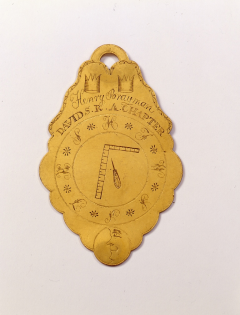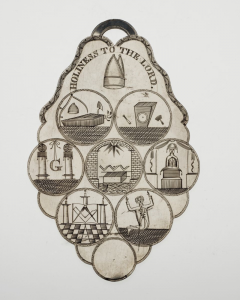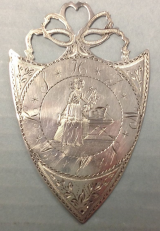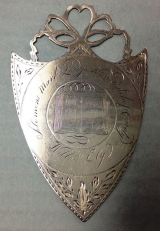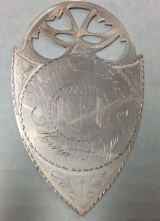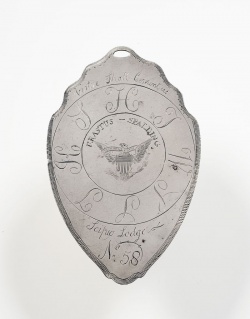En: Mark Medals
James Higgins’ Mark Medal
Source: Scottish Rite Masonic Museum & Library
A year ago the Scottish Rite Masonic Museum and Library was lucky enough to receive a give of a collection of chapter pennies and badges, mostly dating from the early 1900s. Mixed in with the comparatively modern tokens was an engraved silver mark medal that belonged to James Higgins, made in the 1810s or 1820s (below, at left).
As regular blog readers know, these individually commissioned badges can be fascinating.This one sparked our interest because of its intriguing shape and similarity to another in the collection: a gilded and engraved crafted for Henry Brayman, a member of David’s Royal Arch Chapter (at left).
Both of these medals were cut in an interesting lobed form. One side is engraved with the owner’s name and chapter, the other bears the Royal Arch motto “Holiness to the Lord,” a mitre and eight circles (both below, at left). Within each circle the engraver illustrated selections of Masonic symbols or scenes that relate to the Mark Master degree. For example, the circle on the upper right contains images of a keystone, chisel and mallet—all symbols of the Mark Master degree.The circle at the lower left encloses three candles, an open Bible, a square and compasses—the lesser and greater lights of the lodge. Comparison of the symbols and scenes engraved within the circles points to a common inspiration for these vignettes, although we don’t yet know what it is. Each medal also features an integrated hanging loop at its top, as well as similarly styled script letters in the mnemonic “HTWSSTKS” separated by simple flowers, and a trailing vine embellishing the top edge of the medal by the loop. Together, the similarities between the two medals suggest they may be the work of the same engraver.
The man who owned the gilded medal, Henry Brayman, belonged to David’s Chapter No. 34 and St. Paul’s Lodge in Auburn, New York. He may have been the Henry Brayman (1791-1853) who lived in Aurelius and later Buffalo, New York. James Higgins owned the silver medal. He is likely the James Higgins (1766-1827) who was born in Connecticut but later lived in Hamilton, New York, where he worked as a cabinetmaker, hotel keeper and tanner. He was a member of Hamilton Lodge, No. 121, as well as Cyrus Royal Arch Chapter No. 50 of Eaton, New York. Brayman selected a personal mark of a square and awl and had these the symbols engraved on his medal along with his name. James Higgins never had his mark incised on his badge, for reasons we can only speculate about. Hopefully ongoing research will uncover more about these expertly crafted and interestingly decorated medals. If you have any insights to share, please let us know in a comment.
Many thanks to Tom Savini, Director, Chancellor Robert R. Livingston Masonic Library, Grand Lodge of New York.
Mark Medals from Dutchess County, New York
As always, we are excited about some of our recent acquisitions! Just a few weeks ago, the Scottish Rite Masonic Museum & Library was able to add two beautifully engraved mark medals to our growing collection. These two medals are each interesting on their own. They also prompted intriguing questions when viewed side by side.
In previous posts we have discussed other mark medals in the collection. These engraved badges feature a specially selected symbol—often related to Freemasonry or the owner’s profession—sometimes along with the owner’s name and his lodge’s name and location. These two shield-shaped mark medals are embellished with intricate pierced tops. These carefully made decorative elements were designed to allow the owner to wear his badge around his neck, suspended from a ribbon.
Each of these medals bears an owner’s name and Masonic lodge. William Ely (dates unknown) belonged to Solomon’s Mark Lodge in Poughkeepsie, New York and commissioned the medal with top pierced to look like a ribbon tied in a bow (see at left). Ely chose a complicated symbol, or mark, for himself: a young woman holding a vine in her left hand and a set of scales in her right. She stands next to a table or counter, decorated with a square and compasses. A mortar and pestle and a bottle sit on it, possibly suggesting apothecary work. The other medal belonged to John Dutcher (dates unknown), a member of Hiram Lodge No. 27 in Amenia, New York. His mark, surrounded by the mnemonic associated with the mark degree and a circle enclosing 15 different Masonic symbols, was a top hat and what looks to be a gavel (see image below at right)—symbols often associated with the office of lodge master.
Ely’s lodge, Solomon’s Lodge of Poughkeepsie, first chartered in 1771, had several numbers over the years it met—1, 56 (the number on this medal and used by the lodge from 1797-1800), 5 and 6. Members are thought to have established a mark lodge, called Solomon’s Mark Lodge, during the late 1700s. Hiram Lodge No. 27—first founded in 1793 as Payne Lodge, called Hiram Lodge after 1797—received a dispensation for a mark lodge in 1810. The Grand Chapter approved the charter for Hiram Mark Lodge No. 65 in 1811.
The Ely and the Dutcher medals are both shield-shaped with different pierced elements. A close look at the sides of the two medals that bear Ely’s and Dutcher’s names show like symbols—an open Bible with a corner of a page folded back—engraved in a similar style (see images at left and below). The image is embellished with the same flourishes at the top and bottom of the open volume. This and other similarities shared by the medals suggests a question: did the same craftsman design and engrave these medals? Hopefully, with further research, we will learn more about these medals' owners and makers. If you have any ideas or insights, be sure to leave a comment below!
References:
Catalog notes, Minute Book, Solomon’s Lodge No. 1, Poughkeepsie, New York (1771-1852), Chancellor Robert R Livingston Masonic Library of the Grand Lodge of New York.
Compiled by Gary L. Heinmiller, Craft Freemasonry in Dutchess County, New York, (Onondaga & Oswego Masonic Districts Historical Societies, March 2010).
Proceedings of the Grand Chapter of Royal Arch Masons of the State of New York, Volume 1. 1798-1853. (Buffalo, New York: Grand Chapter, 1871).
Erastus Spalding's Mark Medal
Every now and then, a researcher’s inquiry will inspire us to take a closer look at an object in the collection—recently this mark medal made for Erastus Spalding (1775-1830) of Scipio, New York. It was added to the collection of the Scottish Rite Masonic Museum & Library a few years ago.
On his medal, formed out of thin sheet silver in the shape of a plumb bob, Spalding commissioned a craftsman to engrave text and symbols. On one side of the medal (shown on the left), Spalding had several Masonic symbols along with a mallet and keystone, emblems related to the mark degree, engraved. On the other side of the medal (shown on the right), for his mark--the symbol he chose to represent himself--Spalding selected elements taken from the Great Seal of the United States. The seal, officially adopted in 1782, featured an eagle supporting striped shield. In one talon the eagle grasps an olive branch, representing peace; in the other the eagle grips arrows, to signify war. From the eagle's beak a banner decorated with the motto E Pluribus Unum (out of many, one) flies. Spalding also directed that a Masonic motto, “Virtue Shall Cement Us,” be incised on the medal, as well as the name of his lodge, Scipio Lodge No. 58.
Born in Connecticut, Spalding first came to Scipio with his parents and siblings in the late 1780s or early 1790s. Spalding’s father, Oliver (1739-1795) served in the Revolutionary War. Grants of land made to former Revolutionary War soliders may have drawn his family to the area. Erastus and some of his brothers seem to have owned land in Scipio after their father’s death (you can see their names near plot 138 on this map). In developing their new community, area men established Scipio Lodge No. 58. Chartered in 1797, the lodge counted Spalding among its early members. He served on a committee that organized the construction of a new lodge building after an 1805 fire and as Junior Warden in 1807. By the early 1810s, Spalding and his family left Scipio. They eventually lived in Charlotte, Rochester and, later, Lockport, New York.
Intriguingly, Scipio Masons did not establish their Royal Arch Chapter--Aurora Chapter No. 64--until 1819, several years after Erastus Spalding had moved. Further research may uncover information about when and where Spalding took the mark degree. Regardless, the text and symbols Spalding had engraved on his medal point to the pride he felt as a Mason and as a citizen of the new United States.
Photographs:
Mark Medal, 1800-1820. New York. Museum Purchase, 2011.021. Photos by David Bohl. References:
A Short History: Scipio Lodge No. 110 (Ann Arbor, Michigan: Edward's Brothers, Inc.), 1940.
Samuel J. Spalding, Spalding Memorial: A Genealogical History of Edward Spalding of Massachusetts Bay and His Descendants, (Boston: Alfred Medge & Son, Printers), 1872.

